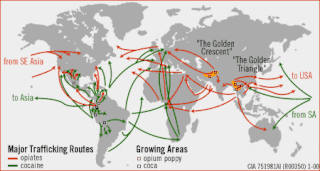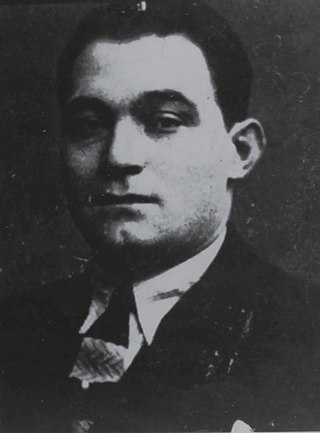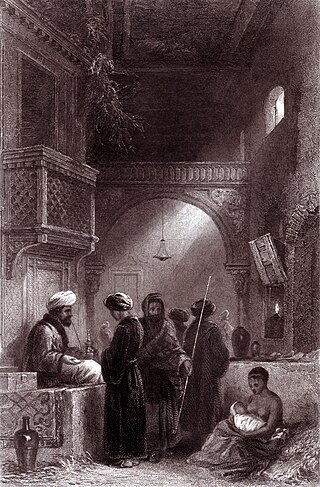
The illegal drug trade or drug trafficking is a global black market dedicated to the cultivation, manufacture, distribution and sale of prohibited drugs. Most jurisdictions prohibit trade, except under license, of many types of drugs through the use of drug prohibition laws. The think tank Global Financial Integrity's Transnational Crime and the Developing World report estimates the size of the global illicit drug market between US$426 and US$652 billion in 2014 alone. With a world GDP of US$78 trillion in the same year, the illegal drug trade may be estimated as nearly 1% of total global trade. Consumption of illegal drugs is widespread globally, and it remains very difficult for local authorities to reduce the rates of drug consumption.
The Havana Conference of 1946 was a historic meeting of United States Mafia and Cosa Nostra leaders in Havana, Cuba. Supposedly arranged by Charles "Lucky" Luciano, the conference was held to discuss important mob policies, rules, and business interests. The Havana Conference was attended by delegations representing crime families throughout the United States. The conference was held during the week of December 22, 1946, at the Hotel Nacional. The Havana Conference is considered to have been the most important mob summit since the Atlantic City Conference of 1929. Decisions made in Havana resonated throughout US crime families during the ensuing decades.

The United States Central Intelligence Agency (CIA) has been accused of involvement in the trafficking of illicit drugs. Books and journalistic investigations on the subject that have received general notice include works by the historian Alfred McCoy, professor and diplomat Peter Dale Scott, journalists Gary Webb and Alexander Cockburn, and writer Larry Collins. These claims have led to investigations by the United States government, including hearings and reports by the United States House of Representatives, Senate, Department of Justice, and the CIA's Inspector General. The various investigations have generally not led to clear conclusions that the CIA itself has directly conducted drug trafficking operations, although there may have been instances of indirect complicity in the activities of others.

The Golden Triangle is a large, mountainous region of approximately 200,000 km2 (77,000 sq mi) in northeastern Myanmar, northwestern Thailand and northern Laos, centered on the confluence of the Ruak and Mekong rivers. The name "Golden Triangle" was coined by Marshall Green, a U.S. State Department official, in 1971 in a press conference on the opium trade. Today, the Thai side of the river confluence, Sop Ruak, has become a tourist attraction, with an Opium Museum, a Hall of Opium, and a Golden Triangle Park, and no opium cultivation.
Ignacio Antinori was an Italian-born American mobster who built one of the earlier narcotics trafficking networks in Florida. Antinori was regarded as the first boss of the Tampa crime family, later known as the Trafficante crime family.
The East Harlem Purple Gang was a gang or organized crime group consisting of Italian-American hit-men and heroin dealers who were semi-independent from the Italian-American Mafia and, according to federal prosecutors, dominated heroin distribution in East Harlem, Italian Harlem, and the Bronx during the 1970s and early 1980s in New York City. Though mostly independent of the Italian-American Mafia and not an official Mafia crew, the gang was originally affiliated with and worked with the Lucchese crime family and later with the Bonanno crime family and Genovese crime family. It developed its "closest ties" with the Genovese family, and its remnants or former members are now part of the Genovese family's 116th Street Crew.
Auguste Joseph Ricord, nicknamed Il Commandante, was a French-Corsican heroin trafficker, convicted Nazi collaborator, and one of the founding members of the French Connection, a mafiosi-type organisation involved in heroin trade, based in France in the 1950s and 1960s. After the liberation, Ricord fled the country. He was sentenced to death in absentia.

François "Lydro" Spirito was a French gangster. He was one of the leaders of the French Connection, and inspired the film Borsalino, which featured Alain Delon and Jean-Paul Belmondo.

Paul Bonnaventure Carbone was a Corsican criminal involved in the Marseille underworld from the 1920s until his death in 1943. He was known as the Emperor of Marseille. Associated with François Spirito, who would become one of the leaders of the French Connection, Carbone inspired the film Borsalino which featured Alain Delon and Jean-Paul Belmondo.
The Unione Corse is a term designating the Corsican organized crime as a whole during the period 1930s–1970s, in the context of the French Connection, an international heroin trade network operated at that time between Turkey, Southern France, and the United States. A 1972 Time article described the "Unione Corse" as a Corsican-based unified and secretive crime syndicate akin to the American Five Families. The local situation in Southern France during this period was in reality more complex, with a nebula of mainly Corsican and Italian-French clans cooperating or fighting each other according to the circumstances and opportunities. If they constituted a key element of the wider French Connection, flooding the American market with Marseille-produced heroin from the 1950s to early 1970s, those clans remained overshadowed by the much more powerful Italian-American Mafia.
The Macedonian mafia is a body of illegal gangs and criminal organizations operating in North Macedonia and within the Macedonian diaspora.
The illegal drug trade in China is influenced by factors such as history, location, size, population, and current economic conditions. China has one-sixth of the world's population and a large and expanding economy. China's large land mass, close proximity to the Golden Triangle, Golden Crescent, and numerous coastal cities with large and modern port facilities make it an attractive transit center for drug traffickers. Opium has played an important role in the country's history since before the First and Second Opium Wars in the mid-19th century.
This article deals with activities of the U.S. Central Intelligence Agency related to transnational crime, including the illicit drug trade.
Marcel Francisci was a French politician and an alleged member of the Unione Corse who was accused of masterminding the French Connection drug network. As a young man, Francisci fought in World War II and was awarded the Croix de Guerre. Following the war, he developed a business empire that included casinos in Britain, France and Lebanon. Francisci served in the general council of the Corse-du-Sud (UDR) and was a member of the Civic Action Service (SAC), a Gaullist militia. He was assassinated in Paris in 1982.

Frank Larry Matthews, also known as Black Caesar, Mark IV and Pee Wee, was an American drug trafficker and crime boss who sold heroin and cocaine throughout the eastern United States from 1965 to 1972. He operated in 21 states and supplied drug dealers throughout every region of the country. The Drug Enforcement Administration (DEA) ranks Matthews as one of the top ten drug traffickers in U.S. history and he is estimated to have had US$20 million in savings.
The Corsican mafia is a set of criminal groups originating from Corsica. The mafia is closely tied to both the French underworld and the Italian Mafia. The Corsican mafia is an influential organized crime structure operating in France, Russia, and many African and Latin American countries.

Slovakia is a Central European country with a history of relatively low crime. While crime became more widespread after the Revolutions of 1989, it remains low when compared to many other post-communist countries.
Organized crime in France is primarily based in major cities like Marseille, Grenoble, Paris, and Lyon. It is often referred to as grand banditisme in France.
Roberto Pannunzi, also known as Bebè (Baby), is an Italian criminal from Rome linked to the 'Ndrangheta, a Mafia-type organisation in Calabria. He is one of the top cocaine brokers for the Sicilian Mafia and the 'Ndrangheta with the Colombian cocaine cartels. He has been described as "Europe's most wanted drugs trafficker", and the "biggest cocaine trafficker in the world", the equivalent of Pablo Escobar, the head of the Colombian Medellín Cartel. According to the United States Drug Enforcement Administration (DEA), the drug trafficking activities of Pannunzi have been documented for over 30 years.

The illegal drug trade in Turkey has played a significant role in its history. Turkish authorities claim that Drug trafficking has provided substantial revenue for illegal groups such as the Kurdistan Workers' Party (PKK), particularly through marijuana cultivation in south-eastern Turkey, and the 1996 Susurluk scandal showed substantial involvement in drug trafficking on the part of the Turkish deep state. The French Connection heroin trade in the 1960s and 70s was based on poppies grown in Turkey.








